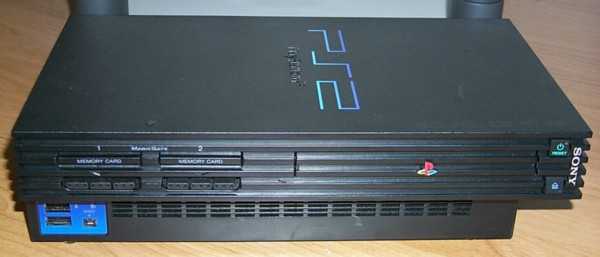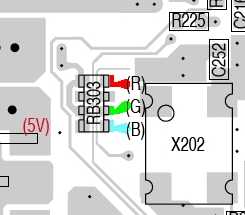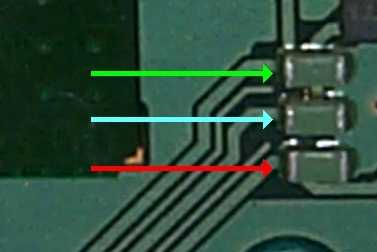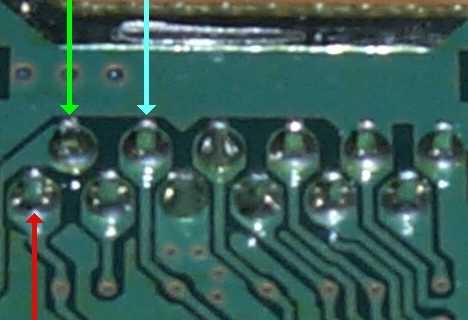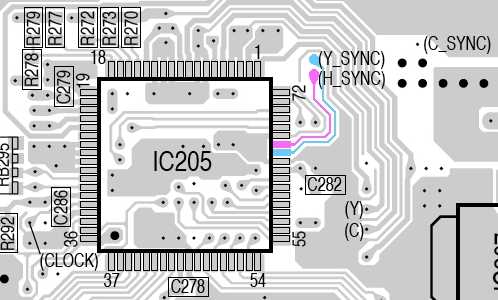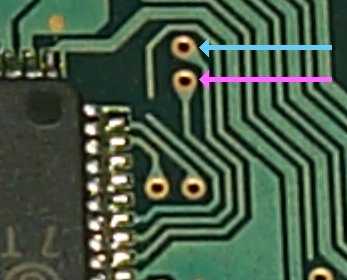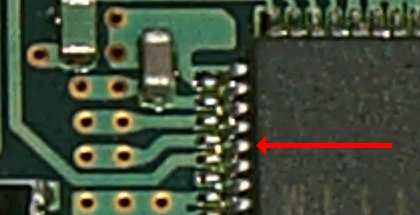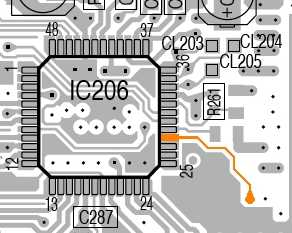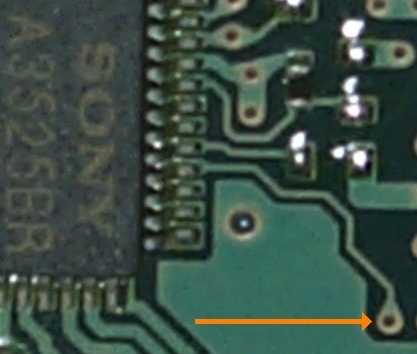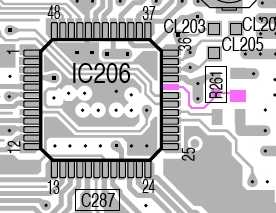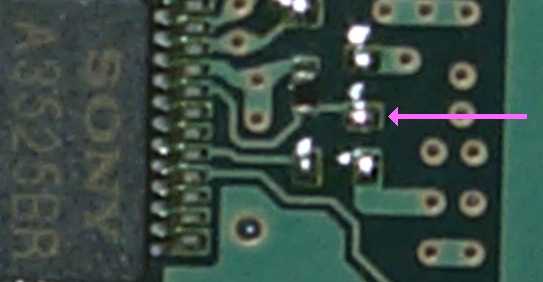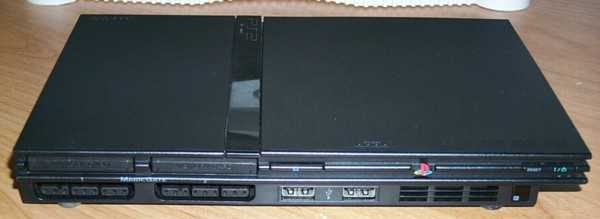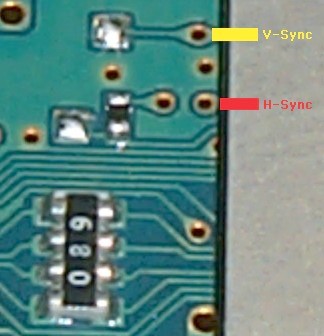Table of Contents
PlayStation 2 RGB/Sync (Original Author: RARusk)
(Updated: May 28, 2007. New information based on acquisition of SCPH-30001 PlayStation 2 Service Manual)
The purpose of this page is to show where one can tap into the RGB video and sync signals off of some PlayStation 2 motherboards. By obtaining the signals straight from the motherboard you can get around the following issues:
- Component Video Forceback - On the PlayStation 2 the three pins that are used for RGB are also used for Component Video. You can switch between RGB and Component Video within the System Configuration section upon startup. Part of the PlayStation 2's copy protection scheme is that when you put a movie into the PS2 it will only play it in Component Video mode regardless of the RGB/Component Video settings. This was due to the fact that Sony wasn't able to properly embed copy protection signals into regular RGB video and thus the machine will switch to Component Video (which can have the MacroVision copy protection signal embedded into it) whenever a movie is played and will remain in Component Video as long as the movie is in the drive. Although DVD burners are the biggest threat to anti-piracy efforts this scheme remains within the PS2 to appease the movie industry (for which Sony is a part of).
- MacroVision - Since the PlayStation 2 does not have a dedicated sync channel the sync has to be taken from either Composite Video or from the Luminance line used for S-Video using a sync separation chip (such as the popular LM1881). When a movie is played the MacroVision copy protection signal is inserted into the video line. Part of what it does is include extra pulses, which mess with the automatic gain control in the recording device, into the non-displayed area of a video signal that can be ignored by TV sets but not by recording devices such as VCRs. However, with the exclusion of the EL1883 and ISL59885 sync chips, all other sync separation chips cannot account for the extra pulses and your picture will get messed up because these MacroVision pulses are mistaken for video sync signals. You will also need something like a GameShark or Region DVD program to turn off the Component Video Forceback then use the EL1883 to watch movies properly in RGB. A bit of a pain. By getting the sync signals from the motherboard you can outright avoid MacroVision without using any additional programs or modchips.
- Sync-On-Green - To take advantage of the Progressive Scan feature on some games (and on movies with newer models of the PS2 (SCPH-50000 and SCPH-70000 units)) the sync has to be included on the green line. Not every RGB monitor can do Sync-On-Green. And even if you manage to use a sync separation chip to get the sync signals you may find yourself with an overly green tint. Monitors that do not use SOG often mistake the sync as some form of brightness signal and you will get the green screen. Removing sync from a channel can be difficult. But by getting the RGB and sync from the motherboard before the sync gets mixed into green you can then be able to use any monitor you want when taking advantage of Progressive Scan. On older motherboards you can also disable Sync-On-Green by grounding a specific pin on one of the chips (this document will show you where).
- Sync Separation Chips - By obtaining the sync signals from the motherboard you will no longer need to use any sync chip for use with the PlayStation 2.
Disclaimer
This page is solely intended for use in allowing one to play games and watch movies in the best possible picture from the PlayStation 2. The author of this page does not endorse or condone movie piracy although in order to achieve the goal of pristine RGB output one must get around the copy protection schemes.
The PlayStation 2 is a very complicated piece of machinery and one should not open it up unless one has a great deal of confidence in one's technical skills (just ask any modchipper or repair person). Personally, I have fragged one board and nearly destroyed another in finding these signals and learning all I can from them. The contacts are very small and can be a real pain in the ass to work with. Great care must be taken when working on a PlayStation 2.
I have made this page as accurate as possible considering the limited resources I have (four motherboards including a Slim PS2). With that said I cannot be held responsible for damage incurred by the user if one attempts to poke around a PS2 motherboard looking for various signals. Don't be afraid to ask around before undertaking such an endeavor or talk to a modder/repair person to see if they can help you out.
The following pictures are from a SCPH-30001 unit (Version 4) motherboard and a SCPH-70012 (Version unknown) motherboard. The Composite Sync circuit comes from Viletim!.
Being that this is a Wiki page you are more than welcome to add any information that will improve the quality of information provided here.
Theory of RGB Operation (SCPH-300xx unit)
There are four chips involved here. The initial signals are sent from the Emotion Engine (CPU) to the Graphics Synthesizer (GPU) to be processed into RGB Analog video. The RGB Analog video is then sent from the GPU to the A3525BR chip (usually found near the A/V plug) to be processed further.
The Graphics Synthesizer is also where the three Sync Signals originate:
- Horizontal Sync (Pin 274).
- Vertical Sync (Pin 273).
- Composite Sync (Pin 272).
Composite Sync is routed straight to the A3525BR chip and Horizontal and Vertical Syncs are split and head to both the A3525BR and SC44728 chips.
The A3525BR chip then takes the RGB video and converts it into the other video modes (Component Video, S-Video, Composite Video) plus routes the RGB video to the A/V plug depending on the user's wishes. This chip will also insert sync on the green line when you use Progressive Scan RGB (480p, 525p, 720p (Linux kit)).
(At this time I don't know exactly how the pin assignments are arranged for the Graphics Synthesizer chip (because there are so many pins) and therefore I don't know exactly where Pins 272, 273, and 274 are located.)
Acquisition of RGB Signals
The RGB signals cannot be tapped from underneath the Graphics Synthesizer chip on a SCPH-300xx style PlayStation 2. However, there are three spots where RGB signals can be acquired on the motherboard:
Location 1
This first spot (on the bottom side of the motherboard - back side of PS2 pointing away from user) is an interesting one. Even though it explicitly states RGB on the picture taken from the Service Manual (top picture with points highlighted), I just get a black screen when I try to tap into it (using a NEC MultiSync 3D monitor). At this time I don't know what I need to do in order to use this spot to acquire RGB Analog video signals.
Location 2
This second spot is not far from the first spot (top side of motherboard - front end of PS2 pointing away from user). In the top picture (from the Service Manual - with traces and points highlighted) you can see three surface mount resistors (R244, R245, R246). You need to attach wires to one side of them (in this orientation - the left side) to get a signal.
(You will also see where the RGB signals originate from the GS chip. Notice there are no vias for the any of the signals and this is why you can't acquire them directly from the chip itself)
The bottom picture shows what the resistors look like. You can see part of the GPU in the lower right corner. The wires must be soldered on the left side of these surface mount units as shown. You will also notice the the order here is RBG instead of RGB.
The only downside here is that the RGB signals need to amplified to be fully usable although these signals are not as weak as the Nintendo 64's RGB signal.
Location 3
The last spot, on the Audio/Video Plug (top side of motherboard - back end of PS2 pointing away from user), is probably the best place to get the RGB signals because they are nice and bright here. However, by acquiring the video signals at this point, you are going to be prone to interference from the MacroVision copy protection signal (DVD playback), Component Video Forceback (DVD playback), and Sync-On-Green (Progressive Scan).
There are ways, explained a little later, that can suppress all interference when using the RGB signals from the A/V Plug.
Acquisition of Sync Signals
The best place to acquire the Horizontal and Vertical Sync signals are near the SC44728 chip as they make their way to it.
The top picture, from the Service Manual (with traces highlighted), clearly show where to get them:
- Horizontal Sync (Pin 66).
- Vertical Sync (Pin 65).
The bottom picture shows where on the Version 4 motherboard to acquire the sync signals. The pink trace and arrow is the Horizontal Sync and the blue trace and arrow is the Vertical Sync.
Although you can see where to tap Composite Sync it is not recommended you get it from that point for reasons explained a little later. If you need it you can make your own Composite Sync signal with two very simple components. First, run the Horizontal Sync through a 1N4148 diode (very common - can be found at Radio Shack). Second, run the Vertical Sync through a 820 Ohm resistor. Once the two signals have been conditioned this way then you can simply splice them together.
In addition, the sync signals may need to be buffered (using a 74hc244) depending on the monitor being used.
MacroVision and Composite Sync
Based on my research into the MacroVision copy protection signal there appears to be two main parts to the signal.
The first part is the colorstripes which are rapidly modulated colorburst signals intended to mess up recording devices in conjunction with the main pulses. I believe that this is controlled by Pin 23 on the SC44728 chip and is highlighted on both pictures. This signal goes to the A3525BR chip and enters it at two points (Pin 5 and Pin 13). This trace can be easily cut to prevent any problems when acquiring RGB signals from the Audio/Video plug. This modification is unnecessary if you acquire the RGB signals from any other point.
The second part of the MacroVision copy protection signal is the main pulses themselves. However, you CANNOT disable that part of the signal. The MacroVision pulses are mixed into the Composite Sync signal when needed. As it turns out, the Composite Sync originates at the Graphics Synthesizer chip and there appears to be no way of disabling the MacroVision signal on the chip. This is why, if you need to have Composite Sync, you have to make it yourself by combining Horizontal and Vertical sync.
Suppression of Component Video
To prevent Component Video Forceback during DVD playback Pin 28 of the A3525BR video chip needs to be connected to Ground. This pin is highlighted (orange) in both pictures.
This modification may be necessary if you intend to acquire the RGB signals from the Audio/Video plug. If you acquire the RGB signals from any other point then this is not required.
Suppression of Sync-On-Green
To prevent Sync-On-Green when using Progressive Scan Pin 32 of the A3525BR video chip needs to be connected to ground. This pin is highlighted (pink) in both pictures. It should be noted that this only affects RGB usage and not Component Video (where the sync would be on the Y/Green line).
This modification may be necessary if you intend to acquire the RGB signals from the Audio/Video plug. If you acquire the RGB signals from any other point then this is not required.
Theory of RGB Operation (SCPH-500xx unit)
In this model Sony did some major re-visioning. They removed the IEEE port, quieted down the fan and DVD drive, and added Progressive Scan DVD playback.
Unfortunately, they also completely redid how the video is done. They went to an all digital format which means that you cannot intercept the RGB signals coming from the GS chip like you could do on the SCPH-30000 units. All of the digital RGB signals go from the GS chip to a new chip: the CXM-4000. This is a Digital to Analog conversion chip (DAC) which converts all of the digital RGB signals to all of the other video formats.
However, thanks to the SCPH-30000 Service Manual, I found that there are vias underneath the Graphics Synthesizer chip where the RGB signals could be tapped (unlike the previous style motherboard which had no vias for RGB under the chip). But when I tried to tap the vias I got just a black screen not unlike when I tried Location 1 on the Version 4 motherboard.
This makes it unclear whether or not the analog signals have been turned off. I hope that they are still on and that I need to find a way to make them show up. In addition, if I can find where Pins 272, 273, and 274 are at on the GS chip then I can find the sync.
Theory of RGB Operation (SCPH-700xx unit)
The reason that this unit is so small is the fact that Sony combined the two main chips (Emotion Engine and Graphics Synthesizer) into one chip called the “EE+GS”. Plus they decided to completely ditch the hard drive bay altogether and shrink the unit further.
Like the SCPH-50000 units this PS2 also uses a DAC chip: the CXM-4015. However, unlike the SCPH-50000 units, I was able to find the sync signals from this motherboard.
Acquisition of Sync Signals
The sync signals can be found very close to the EE+GS chip as shown in the above picture. One of the resistor packs is included as a landmark to help locate the signals.
It is also unclear at this time if the EE+GS chip has any RGB Analog video pins that can be tapped into underneath the chip.
Conclusion
Hopefully in the near future I can find hacks for the CXM chips that will allow users of the newer PS2 models to be able to fully use RGB Analog with no interference.
It is also unknown at this time if anybody has been able to extract the DVD drivers from the SCPH-70000 units so they can be used on the SCPH-30000 units to give them Progressive Scan DVD playback capability.
I also hope that somebody uploads the Service Manuals for the SCPH-50000 and SCPH-70000 units to help complete my PlayStation 2 research.
Author and pictures: RARusk


